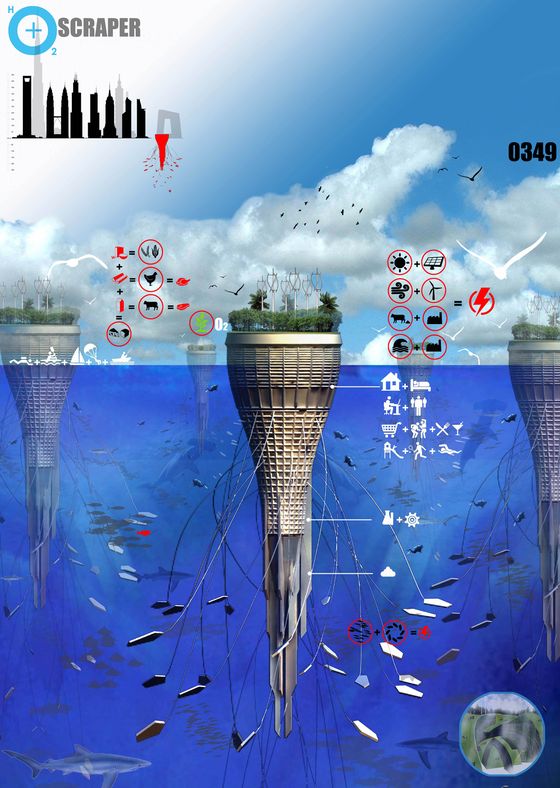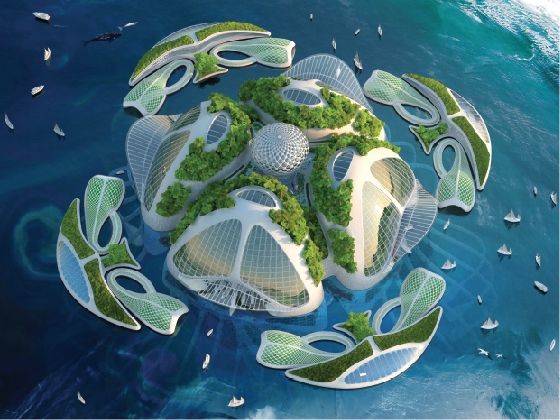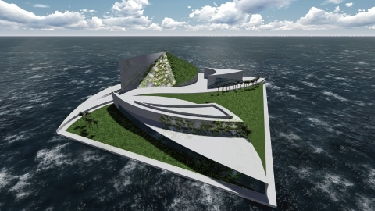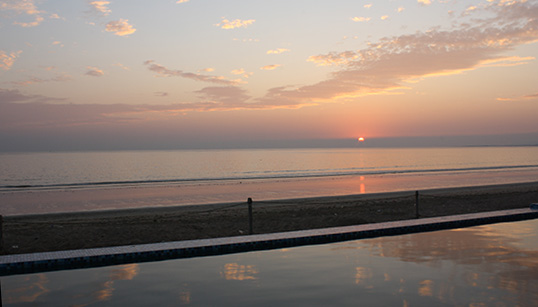Water plays a vital role in shaping our built environment. We depend on it, we use it, we live with it and we must respect it. Exploring innovative technologies that let us live on and within water, Aquatecture puts forward the notion that progress within Architecture & Design relies on the responsible and sustainable consumption of all resources.
Not only does Aquatecture aim to have ‘zero’ negative impacts, it also aims to create and produce Nature. The HO2+ Water Scraper proposal by Malaysian architect Sarly Adre Bin Sarkum, a multi-storey housing tower extending deep into the sea, is designed to feed sea fauna through bioluminescent tentacles, thus ultimately stimulating the vast marine food webs. A pioneering model to look to is Underwater Eco Villages by Belgian architect Vincent Callebaut. As well as living space, each sector would house science labs, offices, hotels, sports fields and farms across 250 floors and reach a depth of up to 3,280 feet. Seawater would be desalinated separately for drinking, microalgae would recycle organic waste, and light would be provided through bioluminescence.

WATER-SCRAPER: DESIGN FOR A FLOATING, SELF-SUFFICIENT CITY. A ‘SPECIAL MENTION’ AWARD WINNER AT THE 2010 EVOLO SKYSCRAPER DESIGN COMPETITION. BY THE MALAYSIAN ARCHITECT SARLY ADRE BIN SARKUM

AEQUOREA: PROPOSED FLOATING COLONY FOR CLIMATE CHANGE REFUGEES. TO BE MADE FROM RECYCLED FLOATING PLASTIC TRASH. BY THE ARCHITECT VINCENT CALLEBAUT.
The Netherlands is one of the lowest lying countries in the world. Over one-quarter of the nation lives below sea level. Sea walls which must be altered in accordance with rising sea levels are being constructed as part of a monumental scheme to eliminate fragile links in the country’s coastal stability. From single homes to office blocks and even roads, the evolution of floating communities and shelter could make low-lying countries habitable during rising sea levels and storm intensification, claims DeltaSync, a Dutch design and research company that specializes in floating architecture.
In their scholarly treatise Aquatecture, Architects Robert Barker and Richard Coutts have outlined new ways of ‘designing for water’, using examples from around the world to illustrate methods of utilizing water innovatively, efficiently and safely. The book explores the historical relationship between water and architecture and how cities and civilizations have been drawn to water and have attempted to control it. It goes on to assess how this relationship has changed over time, and introduces us to a range of brand new techniques that will revolutionize the way we think about water, design and urban planning.
Rising Sea Levels Due to Climate Change
Rising sea levels driven by the thermal expansion of water as well as the melting of land-based glaciers and ice sheets have caused multitudes of people living in low-lying areas to be displaced, turning them into Climate change refugees. Sea levels rose as much as 20 centimeters, or 7.8 inches, over the course of the 20th century, and the Intergovernmental Panel on Climate Change estimates a rise of 18 to 59 centimeters by 2099.
Experts at the National Institute of Oceanography (NIO) predict that rising sea level could sink Karachi displacing 40 million people and causing damage to the national economy. They have warned that Karachi could drown in the next 35-45 years. With parts of the district Malir already having been reclaimed by the sea, the NIO apprehend that Karachi, as we know it, may not exist in the next four decades.

AN ARTIFICIAL FLOATING ISLAND. A RESEARCH BASED CONCEPTUAL DESIGN BY LANDSCAPE

SUNSET AT TURTLE BEACH, KARACHI. CLIMATE CHANGE COULD RESULT IN KARACHI GRADUALLY SINKING BELOW SEA LEVEL. EXPERTS ATTRIBUTE THIS DOOMSDAY SCENARIO TO CHANGES IN WEATHER PATTERNS & TEMPERATURES AS WELL AS UNPLANNED DEVELOPMENT IN COASTAL AREAS
FIRST PUBLISHED IN THE LANDSCAPE NEWSLETTER (NOVEMBER, 2017)

